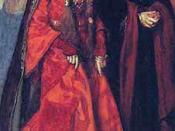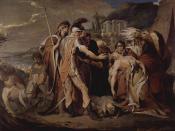An Examination of the Inverse Tropes of Sight and Blindness in King Lear
In King Lear, the recurring images of sight and blindness associated with the characters of Lear and Gloucester illustrate the theme of self-knowledge and consciousness that exist in the play.
These classic tropes are inverted in King Lear, producing a situation in which those with healthy eyes are ignorant of what is going on around them, and those without vision appear to "see" the clearest. While Lear's "blindness" is one which is metaphorical, the blindness of Gloucester, who carries the parallel plot of the play, is literal. Nevertheless, both characters suffer from an inability to see the true nature of their children, an ability only gained once the two patriarchs have plummeted to the utter depths of depravity. Through a close reading of the text, I will argue that Shakespeare employs the plot of Gloucester to explicate Lear's plot, and, in effect, contextualizes Lear's metaphorical blindness with Gloucester's physical loss of vision.
When the audience is first introduced to Lear, he is portrayed as a raging, vain old man who can not see the purity of his daughter Cordelia's love for him from the insincerity of her sisters Goneril and Regan. In his fiery rage after disowning Cordelia, Lear commands to Kent, "Out of my sight!" (1.1.156). Kent fittingly implores the aging king to "See better, Lear; and let me still remain / The true blank of thine eye" (1.1.157-8). Kent recognizes love in its most noble form in the person of Cordelia, and is able to see through the hypocrisy of Lear's other two daughters. In beseeching Lear to "[s]ee better," Kent is, in effect, asking Lear to look beyond his vanity and inward pride to see the honesty of Cordelia, who refuses to...


